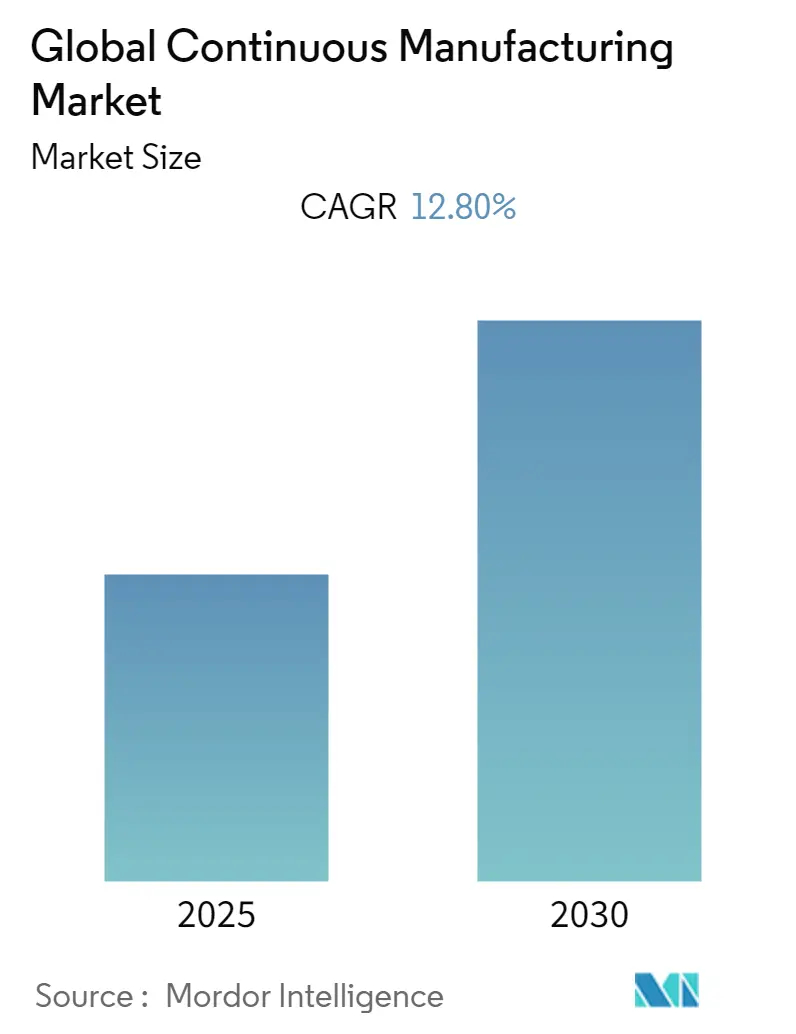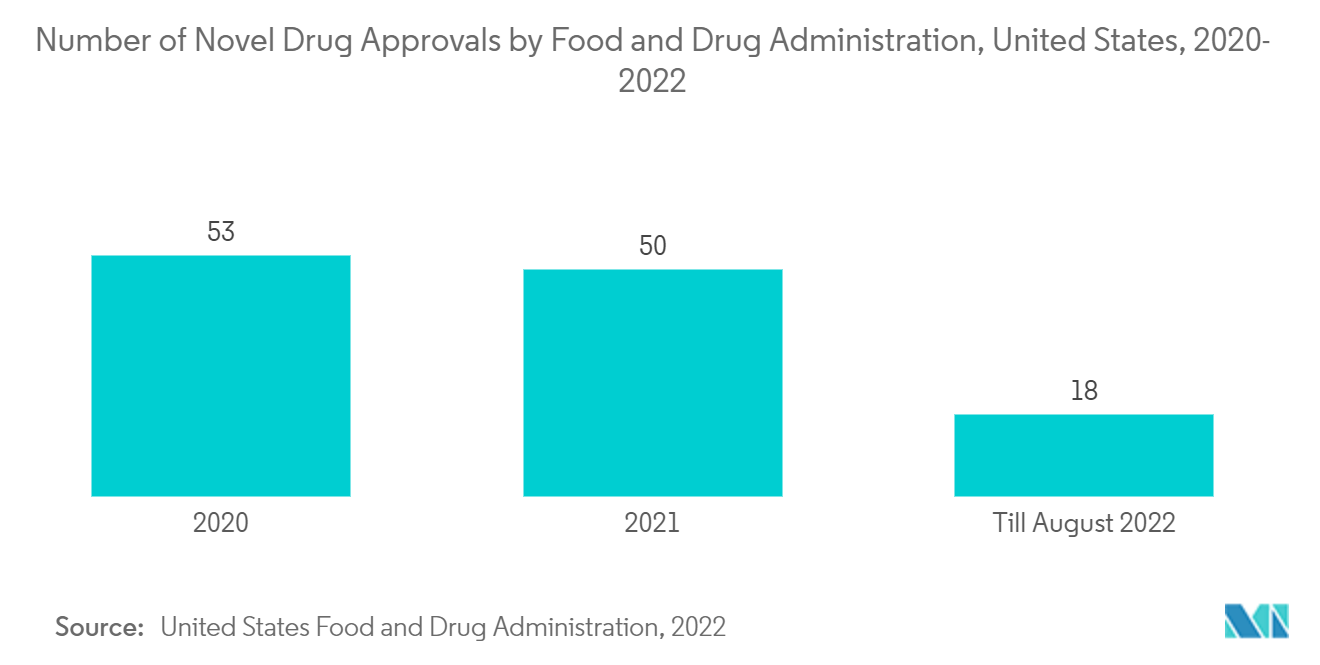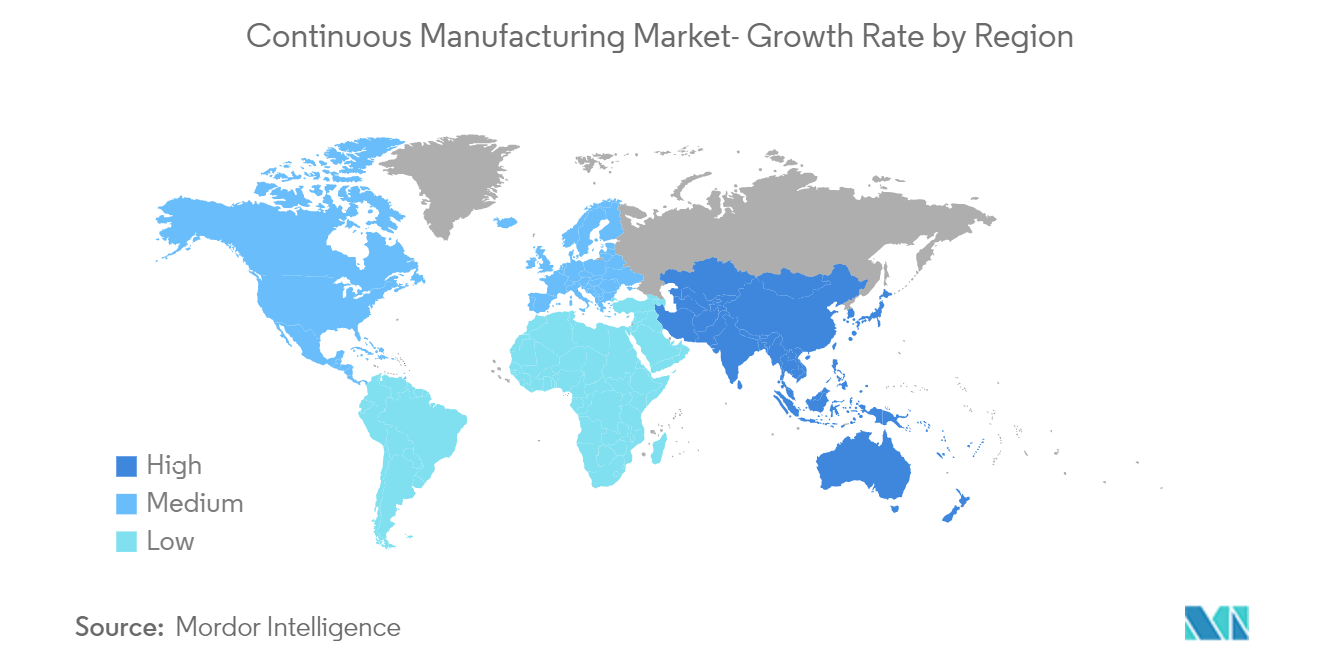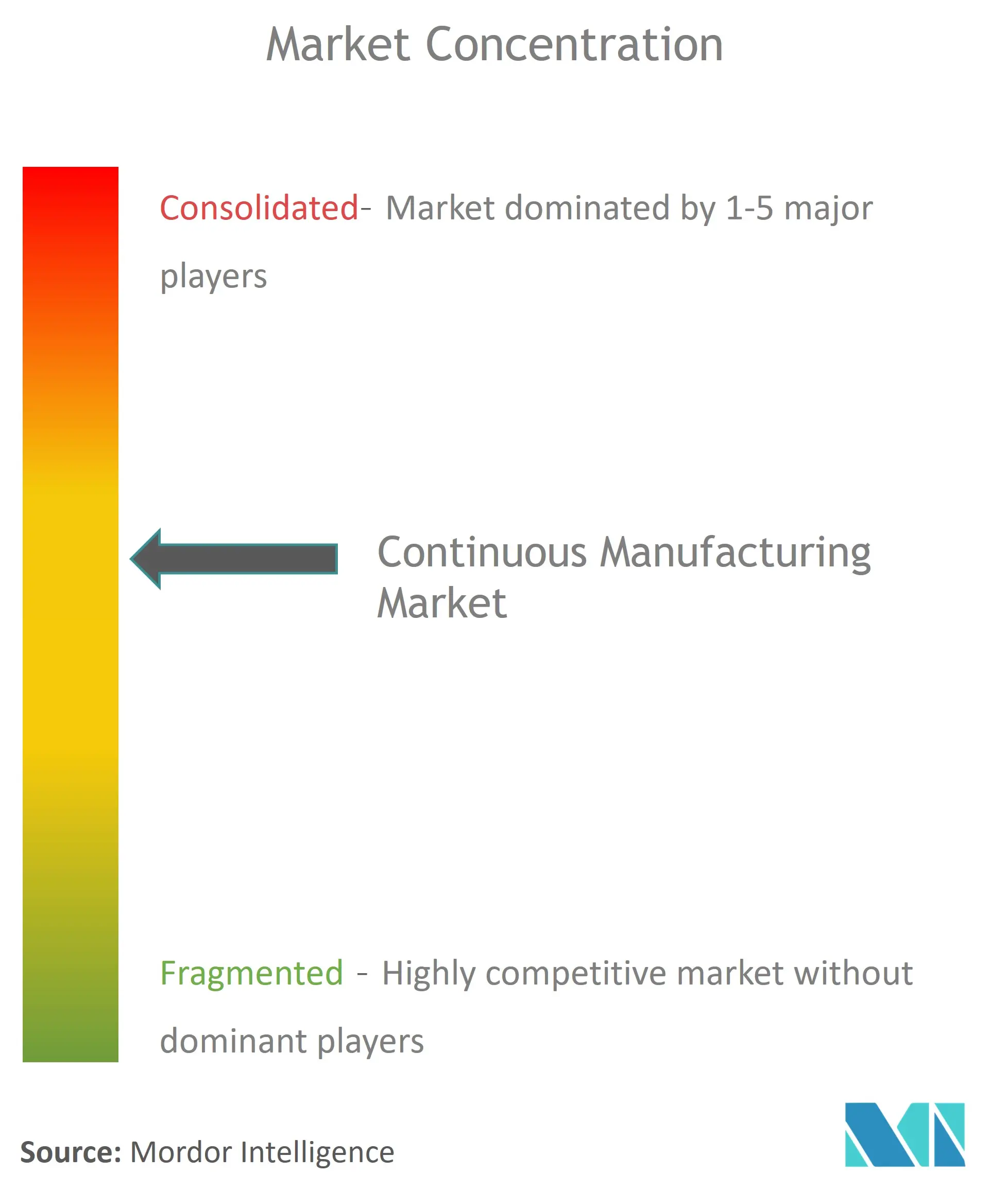
Continuous Manufacturing Market Analysis
The Global Continuous Manufacturing Market is expected to register a CAGR of 12.8% during the forecast period.
The sudden onset of Covid-19 resulted in high demand for pharmaceuticals. The imposition of strict lockdowns across the globe resulted in the lack of labor and supply thereby resulting in the huge demand for pharmaceuticals. Hence, the COVID-19 pandemic led to increasing demand for continuous manufacturing, thereby contributing to the growth of the market. For instance, the article titled "The pandemic effect: making continuous manufacturing a reality" published in September 2021 mentioned that with the ongoing COVID-19 pandemic and the increasing demand for low-cost vaccines and other pandemic-related treatments at an all-time high, big pharmaceutical companies are stepping up efforts to make continuous manufacturing a reality. Thus, the outbreak of the COVID-19 pandemic had a significant impact on the growth of the market.
Continuous manufacturing has been gaining traction in the market studied due to its potential to improve the quality and consistency of medication at lower costs. Furthermore, the adaptation of continuous manufacturing in the pharma industry and the rising demand for medication due to the growing prevalence of diseases around the world is likely to propel the market growth. Continuous manufacturing help manufacturers meet the market demand at the same time, which lowers the cost of manufacturing.
Moreover, technological advancements in manufacturing and support from government agencies are expected to bolster the studied market's growth. The increasing approval for continuous manufacturing is also expected to boost the growth of the market. For instance, in October 2021, the United States Food and Drug Administration (FDA) approved four drugs using continuous manufacturing, which included the first regulatory application using continuous manufacturing for an active pharmaceutical ingredient.
Additionally, the increasing collaborations by the market players are expected to drive the growth of the market. For instance, in September 2020, Emerson and Integra CMS collaborated to accelerate the adoption of continuous pharmaceutical manufacturing.
Thus the above-mentioned factors are expected to drive the growth of the studied market during the forecast period. However, the slow adaptation of continuous manufacturing, lack of regulatory, and technical clarity regarding guidelines may impede the market growth of the market over the forecast period.
Continuous Manufacturing Market Trends
Integrated Continuous Manufacturing is Projected to Grow at Significant Rate Over the Forecast Period
Many pharmaceutical and healthcare manufacturing companies have been adopting continuous manufacturing technologies having automation and minimal human interference. Furthermore, this integrated continuous manufacturing has been benefiting the manufacturers by lowering the production costs, and time, and increasing their margins.
According to the article titled "Continuous manufacturing versus batch manufacturing: benefits, opportunities for manufacturers and regulators" published in January 2021, along with the increased processing speed and control of continuous manufacturing, it will lower the cost of production and grant tremendous cost advantages, especially with high-volume production.
In continuous manufacturing, raw materials are inserted into the system and the final product is produced continuously. This enables the manufacturers to respond quickly to demand. The rising government investments in the companies for improving their existing manufacturing technologies, and the rising number of pharmaceutical manufacturers have been fuelling market growth over the forecast period. For instance, in January 2021, Continuus Pharmaceuticals received a receipt of a USD 69.3 million contract from the United States government to facilitate the domestic production of vital medicines to treat critically ill patients. Contract manufacturing organizations are expected to register a notable growth rate over the forecast period, owing to the increase in the number of contract manufacturing organizations in developing regions. Moreover, the escalating number of drug approvals and the need for more manufacturing facilities to meet the studied market's demand are anticipated to boost the market growth.
Thus, the above-mentioned factors are expected to drive the growth of the studied segment in the market during the forecast period.

North America Dominates the Market and is Expected to Continue the Same Over the Forecast Period
North America is projected to have a significant market share over the forecast period, owing to the presence of key market players and the availability of advanced technologies. Furthermore, favorable regulatory infrastructure and high demand for medicine are projected to boost the market growth in the region. Moreover, high investment in research and development in pharma and biotechnological companies in the region is projected to boost the market growth in the region. For instance, in June 2022, National Resilience Inc. raised USD 625 million in series D financing, which would be spent in part on continuous manufacturing for biologics. Similarly, the rising market player's strategies such as collaborations to obtain a larger market share are also expected to drive the growth of the market in this region. For instance, in May 2022, Agilent collaborated with APC Ltd., for working towards combining their technologies to provide unique workflows to customers that support automated process analysis via liquid chromatography.
Additionally, the increasing support from government organizations is also expected to drive the growth of the studied market in this region. For instance, in October 2021 the United States House of Representatives passed a bill, H.R. 4369 that promotes advanced manufacturing through the creation of national centers for excellence in continuous manufacturing at various universities across the country.
Thus, the above-mentioned factors are expected to drive the growth of the market during the forecast period in this region.

Continuous Manufacturing Industry Overview
The continuous manufacturing market is moderately competitive having a limited number of manufacturers. The market players have been focusing on merging automation with product manufacturing technologies to reduce manufacturing costs and improve efficiency. The market players operating in the market studied include GEA Group AG, Robert Bosch GmbH, Glatt GmbH, Thermo Fisher Scientific, and Siemens, among others.
Continuous Manufacturing Market Leaders
-
Siemens
-
GEA Group AG
-
Glatt GmbH
-
Thermo Fisher Scientific
-
Scott Equipment
- *Disclaimer: Major Players sorted in no particular order
Continuous Manufacturing Market News
- In March 2022, Phlow Corp, a United States essential medicines public benefit company entered alliances with both Virginia Commonwealth University (VCU) Medicines for All institute and AMPAC fine chemicals to provide contract continuous manufacturing research and development services for small molecule pharmaceutical products.
- In March 2022, United States Pharmacopeia (USP) India expanded its footprint in Hyderabad and will be setting up a new continuous manufacturing facility in Hyderabad with an additional capital investment of USD 20 million.
Continuous Manufacturing Industry Segmentation
As per the scope of the report, continuous manufacturing refers to the manufacturing process of products without any interruption. It is the opposite of batch manufacturing. Continuous manufacturing is a method for manufacturing pharmaceutical products from end to end on a single, uninterrupted production line. The continuous manufacturing market is segmented by Product (Integrated Continuous Manufacturing and Semi Continuous Manufacturing), Application(API manufacturing, and End Product Manufacturing), End User (Contract Manufacturers, Pharmaceutical Companies and Other End Users), and Geography (North America, Europe, Asia-pacific, Middle East and Africa, and South America). The market report also covers the estimated market sizes and trends of 17 countries across major regions globally. The report offers values (in USD million) for the above segments.
| By Product | Integrated Continuous Manufacturing | ||
| Semi Continous Manufacturing | Continuous Blenders | ||
| Continuous Granulators | |||
| Continuos Coaters | |||
| Continuous Compressors | |||
| Continuous Dryers | |||
| Other Semi-continuous Manufacturing Products | |||
| By Application | API Manufacturing | ||
| End Product Manufacturing | |||
| By End User | Contract Manufacturers | ||
| Pharmacuitical Companies | |||
| Other End Users | |||
| Geography | North America | United States | |
| Canada | |||
| Mexico | |||
| Europe | Germany | ||
| United Kingdom | |||
| France | |||
| Italy | |||
| Spain | |||
| Rest of Europe | |||
| Asia-Pacific | China | ||
| Japan | |||
| India | |||
| Australia | |||
| South Korea | |||
| Rest of Asia-Pacific | |||
| Middle East and Africa | GCC | ||
| South Africa | |||
| Rest of Middle East and Africa | |||
| South America | Brazil | ||
| Argentina | |||
| Rest of South America | |||
Continuous Manufacturing Market Research FAQs
What is the current Global Continuous Manufacturing Market size?
The Global Continuous Manufacturing Market is projected to register a CAGR of 12.8% during the forecast period (2025-2030)
Who are the key players in Global Continuous Manufacturing Market?
Siemens, GEA Group AG, Glatt GmbH, Thermo Fisher Scientific and Scott Equipment are the major companies operating in the Global Continuous Manufacturing Market.
Which is the fastest growing region in Global Continuous Manufacturing Market?
Asia Pacific is estimated to grow at the highest CAGR over the forecast period (2025-2030).
Which region has the biggest share in Global Continuous Manufacturing Market?
In 2025, the North America accounts for the largest market share in Global Continuous Manufacturing Market.
What years does this Global Continuous Manufacturing Market cover?
The report covers the Global Continuous Manufacturing Market historical market size for years: 2019, 2020, 2021, 2022, 2023 and 2024. The report also forecasts the Global Continuous Manufacturing Market size for years: 2025, 2026, 2027, 2028, 2029 and 2030.
Our Best Selling Reports
Continuous Manufacturing Industry Report
Statistics for the 2025 Global Continuous Manufacturing market share, size and revenue growth rate, created by Mordor Intelligence™ Industry Reports. Global Continuous Manufacturing analysis includes a market forecast outlook for 2025 to 2030 and historical overview. Get a sample of this industry analysis as a free report PDF download.




